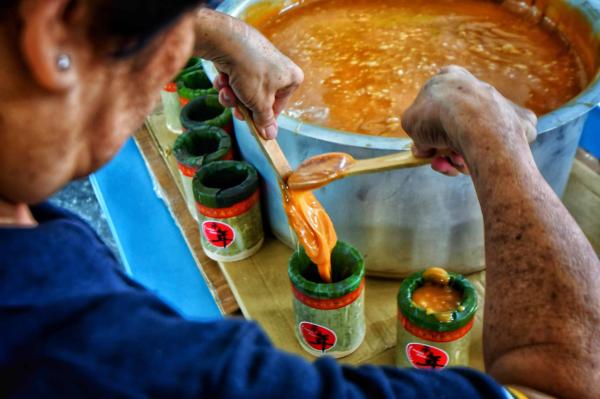By Nazli Ibrahim
SHAH ALAM, Jan 30 — In the serene town of Kuala Kubu Baharu, the art of making nian gao — known in Malay as kuih bakul — stands out for its intricacy. Unlike the common method of using milk cans as moulds, this traditional Chinese delicacy is shaped in bamboo and ceramic bowls.
Though it requires only two ingredients, preparing this timeless treat is anything but simple. It demands meticulous attention and three days of dedication to preserve its authentic flavour and texture.
The steaming process takes up to 18 to 20 hours over a high flame. As the mixture gradually thickens, it requires stirring with significant strength to maintain its consistency. Adding to the traditional charm, rubberwood and rambutan wood are used as fuel, replacing modern gas stoves.
“Rubberwood produces a strong flame, while rambutan wood creates a lighter one. The combination of both makes it easier to control the fire,” said entrepreneur Chong Qing Wern, 30, during an interview with Media Selangor in Kampung Assam Kumbang, Kuala Kubu Baharu, on January 10.
[caption id="attachment_388284" align="aligncenter" width="1080"] A knife is tied to a steamer used to cook nian gao, to ward off A worker makes nian gao in conjunction with Chinese New Year, at Kampung Assam Kumbang, Kuala Kubu Baharu, on January 12, 2025. — Picture by MOHD KHAIRUL HELMY MOHD DIN/MEDIA SELANGOR[/caption]
A knife is tied to a steamer used to cook nian gao, to ward off A worker makes nian gao in conjunction with Chinese New Year, at Kampung Assam Kumbang, Kuala Kubu Baharu, on January 12, 2025. — Picture by MOHD KHAIRUL HELMY MOHD DIN/MEDIA SELANGOR[/caption]
Chong said a knife is traditionally tied to the steamer lid as a symbolic measure to ward off evil spirits, a practice rooted in Chinese cultural beliefs.
To start the process, glutinous rice is mixed with water, finely ground into flour, and left to drain for 10 to 12 hours.
Once ready, the rice flour is mixed with sugar before being steamed. It is then poured into bamboo moulds and bowls lined with banana leaves, where it hardens and sets as it cools.
“In other places, nian gao is poured into a milk can lined with banana leaves. Once it cools and hardens, it is removed from the can while still wrapped in the banana leaves. What makes the Kuala Kubu Baharu nian gao special is that we pour it into bamboo moulds with banana leaves,” he said.
[caption id="attachment_388286" align="aligncenter" width="1080"] Bags of soaked glutinous rice drain ahead of the nian gao making process at Kampung Assam Kumbang, Kuala Kubu Baharu, on January 12, 2025. — Picture by MOHD KHAIRUL HELMY MOHD DIN/MEDIA SELANGOR[/caption]
Bags of soaked glutinous rice drain ahead of the nian gao making process at Kampung Assam Kumbang, Kuala Kubu Baharu, on January 12, 2025. — Picture by MOHD KHAIRUL HELMY MOHD DIN/MEDIA SELANGOR[/caption]
Young hands learn old practices
Proudly to have inherited the recipe from the elders in the community, Chong said nian gao brand, Cheng Nian, gets its name from the two-day cooling process, which is essential to achieve the delicacy’s signature firm texture.
“Cheng” symbolises heritage, while “nian” refers to the rice cake. Together, they signify the preservation of the tradition of preparing the delicacy.
“Cheng” also means to carry or support, referring to the spirit of the younger generation and their enthusiasm to preserve and pass down the practice to future generations.
The preparation of nian gao requires precise care, as the Chinese community believes its quality directly impacts their “ong” — or luck — for the entire year.
Steeped in tradition, the process is also guided by specific taboos, such as prohibiting the participation of menstruating women and those mourning a family member who died within the last 100 days. Additionally, uttering negative words during the process is also forbidden.
[caption id="attachment_388287" align="aligncenter" width="1080"] Cheng Nian owner Chong Qing Wern shows off his nian gao at Kampung Assam Kumbang, Kuala Kubu Baharu, on January 12, 2025. — Picture by MOHD KHAIRUL HELMY MOHD DIN/MEDIA SELANGOR[/caption]
Cheng Nian owner Chong Qing Wern shows off his nian gao at Kampung Assam Kumbang, Kuala Kubu Baharu, on January 12, 2025. — Picture by MOHD KHAIRUL HELMY MOHD DIN/MEDIA SELANGOR[/caption]
Tradition meets charity
Cheng Nian prices the Chinese New Year delicacy at RM18, RM23, and RM28, depending on size.
For those seeking something extra, Cheng Nian is auctioning off 12 special editions of nian gao featuring intricate images of the Chinese zodiac animal. The price, starting at an auspicious RM288, aligns with the Chinese community’s belief in the number eight’s ability to bring good fortune for the year.
In a meaningful gesture, proceeds from the auction will be donated to several schools.
Widely regarded as a “must-have” delicacy for celebrations, nian gao represents aspirations for continuous growth in the year ahead. Its popularity has extended beyond the Klang Valley, with orders pouring in from as far as Sabah, highlighting the universal appeal of Kuala Kubu Baharu’s cherished traditional recipe.
This season, Cheng Nian prepared an impressive 800 pieces of nian gao, which required 178kg each of glutinous rice and sugar, and were carefully steamed in eight large pans.
[caption id="attachment_388290" align="aligncenter" width="1200"] Kuala Kubu Baharu residents fill banana leaf-lined moulds with a cooked nian gao mixture at Kampung Assam Kumbang on January 12, 2025. — Picture by MOHD KHAIRUL HELMY MOHD DIN/MEDIA SELANGOR[/caption]
Kuala Kubu Baharu residents fill banana leaf-lined moulds with a cooked nian gao mixture at Kampung Assam Kumbang on January 12, 2025. — Picture by MOHD KHAIRUL HELMY MOHD DIN/MEDIA SELANGOR[/caption]




